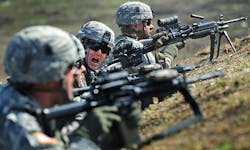As the infantry adapts to commercial technology, questions remain on how best to use it
The first warning that they're suddenly in grave danger might be a wisp of smoke, a ricocheting bullet, or the pop or a mortar launch nearby. In a moment they could be in an ambush -- pinned down and surrounded -- with incoming fire from what seems like all directions.
Under heavy pressure, members of the rifle squad hug the ground, radio for help, and desperately look around for signs of the enemy. Squad mates start taking hits, yet the squad still isn't certain of how and where to fight back. Although help is on the way, it's many minutes out at a moment when seconds count.
This kind of scenario is increasingly common for the infantry in an era when they typically operate in far-away unfamiliar surroundings in which the enemy blends in with the civilian population, has wide access to tactical communications systems like cell phones, can sow booby traps called improvised explosive devices (IEDs), and has intimate knowledge of the local terrain and culture.
In other words the enemy has far superior situational awareness than do members of the infantry rifle squad whom they have pinned down and in their sights.
Related: Lockheed Martin moves forward in DARPA program to boost capabilities of infantry technology
At this moment, however, things are not all bad. The rifle squad, for example, has a technological advantage with a variety of sensors, wearable computers, secure radio communications, and superior fire power. Still, technology itself may not be the answer, but instead may have to do with using the technology that's available.
The U.S. Defense Advanced Research Projects Agency (DARPA) in Arlington, Va., is working with Lockheed Martin Corp. to sort out some of today's conundrums of how the infantry can use modern technology to best advantage in bad circumstances.
This isn't a new issue for U.S. warfighters. One of the military's biggest challenges today is to sort out a continuing avalanche of new commercially developed technologies, finding those that are most suitable for warfighters in the field, and adapting these technologies to the military's chain of command.
Given a commercial cell phone and working cell network today, for example, and a private soldier in a foxhole could phone the White House. Despite having this capability, however, that's rearely the best idea. The trick is to use available technology to enable infantry to fight harder, longer, and smarter.
This is where the DARPA Squad X Core Technologies (SXCT) program comes in. It seeks to develop new technologies that give infantry squads of eight to 14 members increased situational awareness, as well as improved capabilities in precision engagement, non-kinetic engagement, squad sensing, and squad autonomy to enable these front-line warfighters to adapt to quickly changing battlefield conditions.
In particular, the DARPA SXCT program seeks to develop new kinds of guided ammunition for current squad equipment like the M203/M320 grenade launchers or the Picatinny Rail system. One weapon that could emerge from this program is a micro-missile or advanced 40-millimeter grenade that can engage unseen targets with precision using the networked squad, small unmanned vehicles, and data-fusion-enabled shared situational awareness.
Other SXCT thrusts include tactical battlefield cyber, optical, and electronic warfare jammers to disrupt enemy communications and weapons control; handheld radar, and small sensors that look and listen for enemy sounds like heart beats or infrared signatures.
The Lockheed Martin Corp. Missiles and Fire Control segment in Grand Prairie, Texas, won an SXCT phase-2 contract this month to start refining and enhancing infantry technology concepts developed in the program's first phase.
It's likely to be a while before any SXCT technologies could be deployed in the field, and also possible the program won't ever yield any promising solutions. Still, this is encouraging news to any infantryman who's ever been pinned down in enemy territory.
Learn more: search the Aerospace & Defense Buyer's Guide for companies, new products, press releases, and videos
